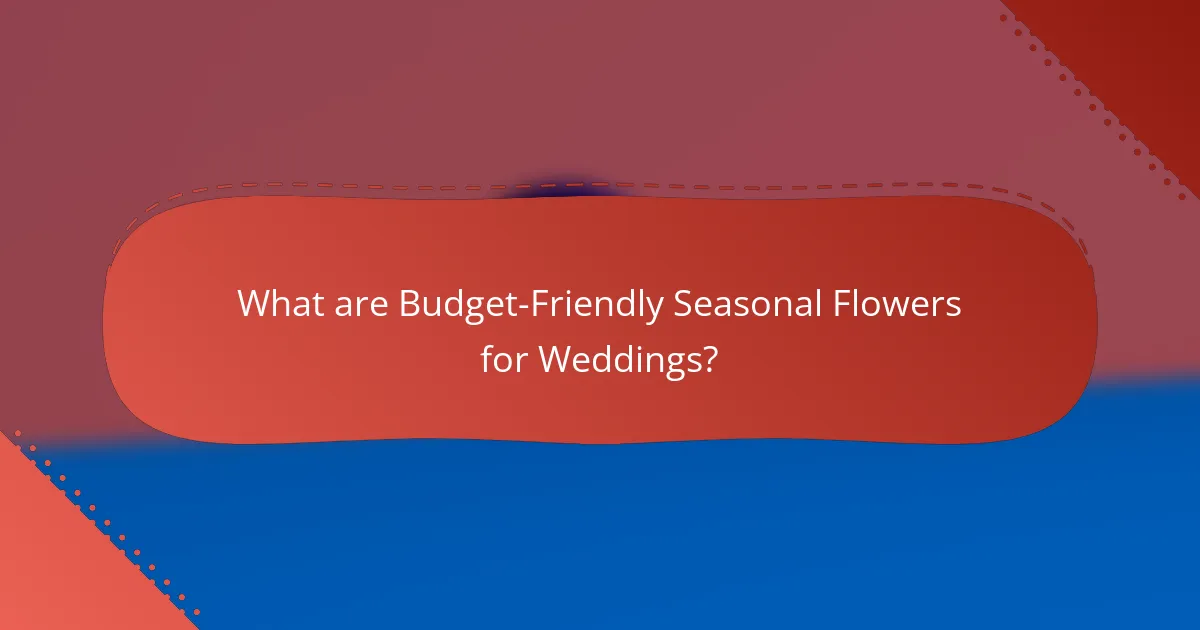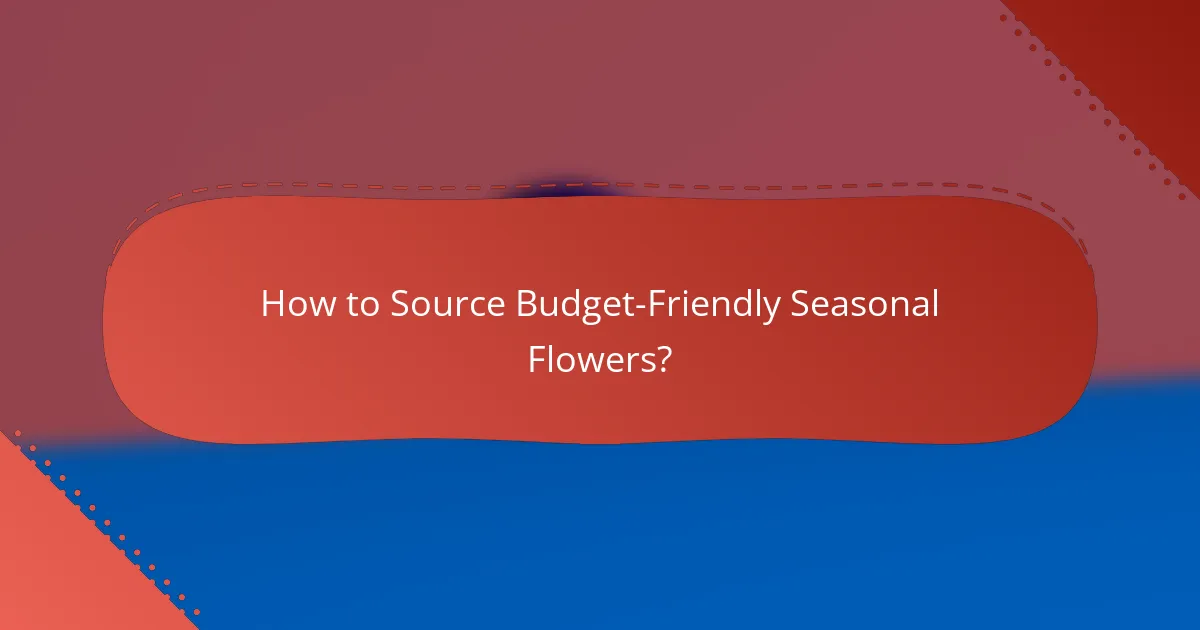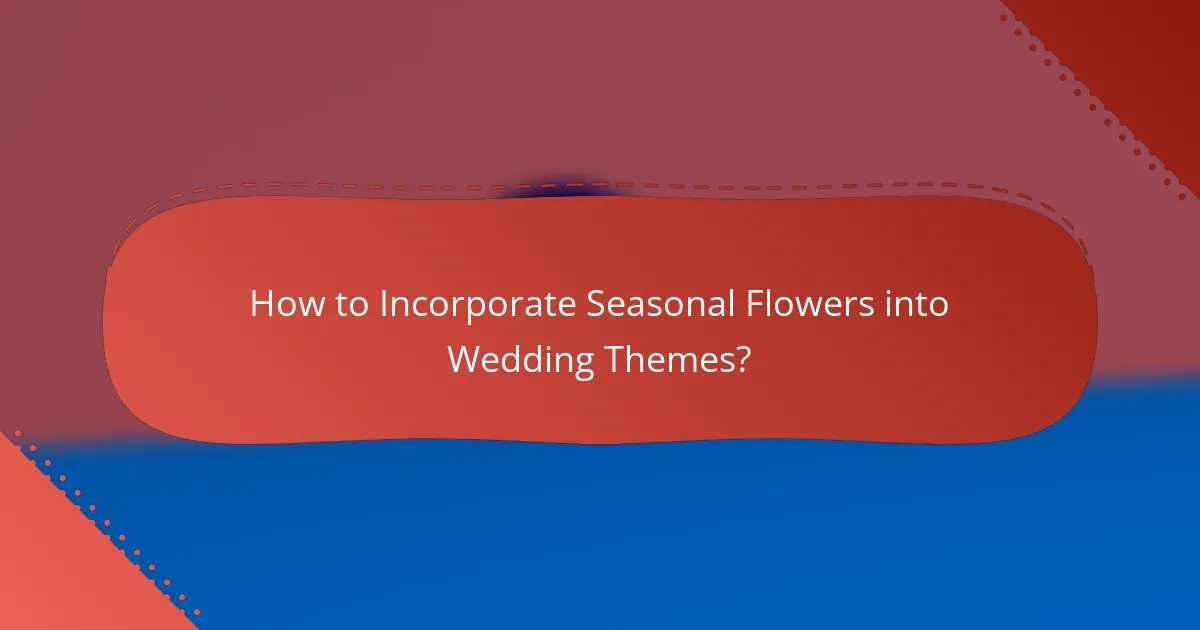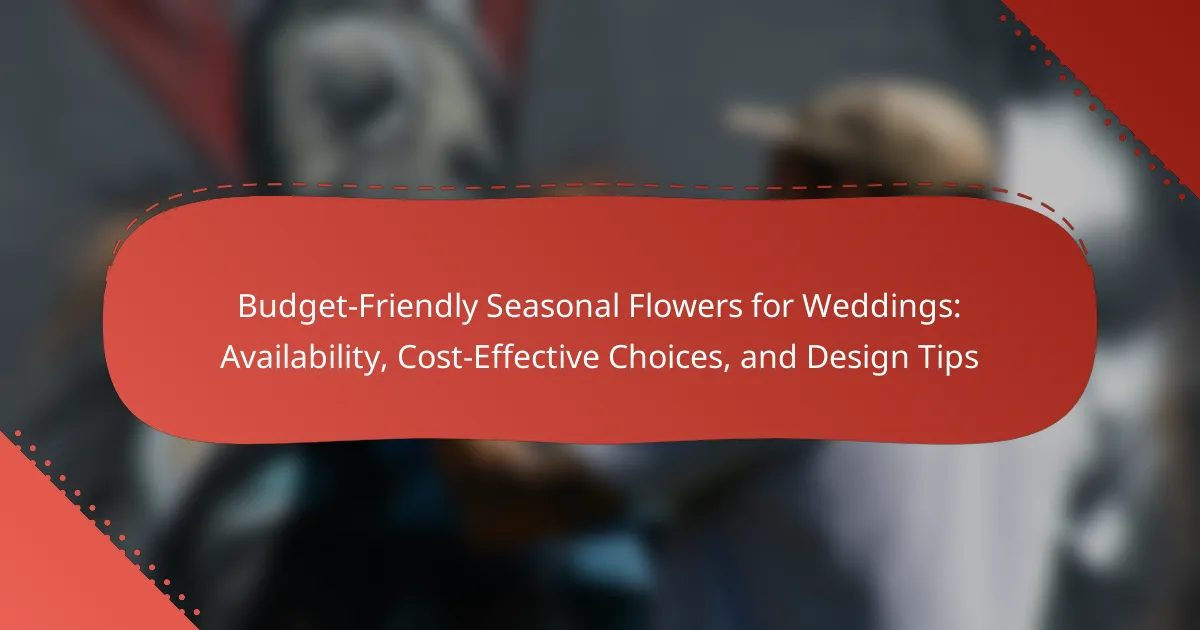
What are Budget-Friendly Seasonal Flowers for Weddings?
Budget-friendly seasonal flowers for weddings include daisies, sunflowers, and chrysanthemums. These flowers are often more affordable due to their availability during specific seasons. Daisies bloom in spring and summer, making them a cost-effective choice for many weddings. Sunflowers are available in late summer and fall, providing a vibrant option at a lower price. Chrysanthemums are abundant in the fall, offering various colors and styles. Choosing these flowers can significantly reduce wedding floral expenses while maintaining beauty.
How can seasonal flowers reduce wedding costs?
Seasonal flowers can reduce wedding costs by being more readily available and less expensive than out-of-season varieties. When flowers are in season, they require less transportation and storage, which lowers their price. For example, peonies are typically more affordable in late spring when they are in season. Additionally, local sourcing of seasonal flowers can further decrease costs. This is because local growers often sell flowers at lower prices compared to imported options. By choosing seasonal flowers, couples can allocate their budgets more effectively, allowing for other wedding expenses.
What are the benefits of choosing seasonal flowers for weddings?
Choosing seasonal flowers for weddings offers several benefits. Seasonal flowers are typically more affordable due to their abundance. They are grown locally, which reduces transportation costs. Freshness is another advantage; seasonal flowers are at their peak during their natural blooming period. This results in vibrant colors and longer-lasting arrangements. Additionally, using seasonal flowers supports local farmers and sustainable practices. It also allows for more creative and unique floral designs that reflect the time of year. Overall, seasonal flowers enhance the wedding’s aesthetic while being budget-friendly and environmentally conscious.
How does the availability of seasonal flowers impact wedding planning?
The availability of seasonal flowers significantly influences wedding planning. Seasonal flowers are more accessible and cost-effective than out-of-season varieties. This availability allows couples to stay within budget while achieving their desired floral aesthetics. For instance, peonies are abundant in late spring, making them a popular choice for weddings during that time. In contrast, using out-of-season flowers can increase costs due to import fees and transportation. Additionally, seasonal flowers often boast better quality and freshness, enhancing the overall look of wedding arrangements. Therefore, planning around seasonal availability can streamline the selection process and optimize costs.
What types of seasonal flowers are best for weddings?
Spring weddings benefit from tulips, daffodils, and peonies. These flowers are vibrant and symbolize renewal. Summer weddings often feature sunflowers, roses, and hydrangeas. They add color and are widely available. Autumn weddings can include chrysanthemums, dahlias, and asters. These flowers reflect the season’s rich hues. Winter weddings may utilize poinsettias, amaryllis, and evergreens. These options provide elegance and seasonal charm. Each type of flower aligns with its respective season, ensuring freshness and aesthetic appeal.
Which flowers are in season during spring, summer, fall, and winter?
Spring flowers include tulips, daffodils, and hyacinths. These flowers bloom from March to May. Summer flowers consist of sunflowers, daisies, and peonies. They are available from June to August. Fall flowers include chrysanthemums, asters, and dahlias. These bloom from September to November. Winter flowers consist of poinsettias, amaryllis, and hellebores. They are in season from December to February. Each season offers a variety of flowers suitable for weddings, aligning with budget-friendly options.
How do the characteristics of these flowers influence their use in wedding designs?
The characteristics of budget-friendly seasonal flowers significantly influence their use in wedding designs. Their availability aligns with seasonal trends, ensuring couples can source flowers easily. Cost-effective choices help couples manage their budgets while achieving beautiful arrangements. The color palette of these flowers can match wedding themes, enhancing the overall aesthetic. Durability affects how well flowers hold up during the event, ensuring they look fresh throughout the day. Fragrance can add to the ambiance, creating a memorable experience for guests. Lastly, the size and shape of the flowers determine their suitability for various arrangements, from bouquets to centerpieces.
What design tips can enhance the use of seasonal flowers?
Use a variety of heights and textures to create visual interest with seasonal flowers. Incorporate complementary colors to enhance the overall aesthetic. Group flowers in odd numbers for a more natural look. Utilize foliage to add depth and contrast. Choose containers that match the theme of the wedding for cohesion. Arrange flowers in clusters to create focal points. Use seasonal flowers that are readily available to reduce costs. Seasonal flowers often have a longer vase life, ensuring freshness throughout the event.
How can color palettes be effectively paired with seasonal flowers?
Color palettes can be effectively paired with seasonal flowers by selecting hues that complement the flowers’ natural colors. Understanding the color wheel is essential for this process. For example, warm colors like reds and oranges work well with autumn blooms. Similarly, pastel shades can enhance the beauty of spring flowers.
Using contrasting colors can create visual interest. A vibrant flower against a muted palette can stand out beautifully. Additionally, monochromatic schemes can provide a sophisticated look. This involves using different shades of the same color for both the flowers and the decor.
Seasonal availability should also guide color choices. For instance, summer flowers like sunflowers can be paired with bright yellows and greens. In contrast, winter flowers may be better suited to cooler tones like blues and whites.
Ultimately, the goal is to create harmony between the flowers and the overall design. This enhances the aesthetic appeal of any wedding setting.
What are some creative arrangements for seasonal flowers in wedding decor?
Creative arrangements for seasonal flowers in wedding decor include centerpieces, bouquets, and floral arches. Centerpieces can feature a mix of seasonal blooms in varying heights. Bouquets can incorporate seasonal flowers with greenery for texture. Floral arches can frame the ceremony space using cascading seasonal arrangements. Seasonal flower choices often reflect the wedding’s time of year. For example, spring weddings may use peonies and tulips, while autumn weddings might feature chrysanthemums and dahlias. These arrangements not only enhance aesthetics but also align with budget-friendly choices, as seasonal flowers are typically more affordable.

How to Source Budget-Friendly Seasonal Flowers?
To source budget-friendly seasonal flowers, consider purchasing directly from local farms or farmers’ markets. These sources often offer lower prices than retail florists. Additionally, buying in bulk can reduce costs significantly. Research shows that seasonal flowers are typically more affordable due to their abundance. For example, peonies are cheaper in late spring, while sunflowers are cost-effective in summer. Another strategy is to choose flowers that are in season in your area. This approach minimizes shipping costs and supports local growers. Finally, consider using filler flowers and greenery to enhance arrangements without increasing expenses.
Where can couples find affordable seasonal flowers for their weddings?
Couples can find affordable seasonal flowers for their weddings at local farmers’ markets. These markets often feature fresh, locally sourced blooms at lower prices than retail florists. Additionally, online platforms like Etsy and local flower co-ops provide cost-effective options. Many of these sources offer seasonal varieties that are more budget-friendly. According to the Society of American Florists, using in-season flowers can reduce costs by up to 30%. Buying directly from growers typically eliminates middlemen, further lowering expenses. Couples should also consider DIY arrangements for additional savings.
What are the advantages of buying from local growers or farmers’ markets?
Buying from local growers or farmers’ markets offers several advantages. Freshness is a key benefit, as products are often harvested shortly before sale. This results in better flavor and quality. Supporting local economies is another advantage; purchasing directly from farmers helps sustain their livelihoods. Additionally, buying locally reduces transportation costs and carbon emissions. Seasonal availability ensures flowers are at their peak, enhancing aesthetic appeal for weddings. Farmers’ markets also foster community connections, allowing consumers to engage with growers directly. Overall, these factors contribute to a more sustainable and enriching purchasing experience.
How can online flower delivery services help in finding budget-friendly options?
Online flower delivery services can help in finding budget-friendly options by offering a wide range of price points. These services often provide seasonal flowers which are typically less expensive. They also allow customers to compare prices easily across different vendors. Many online platforms feature discounts and promotions that can further reduce costs. Additionally, customers can select from various arrangements that fit their budget. Some services provide subscription options for regular deliveries at a lower overall cost. By using online tools, customers can filter by price to find affordable choices quickly. This convenience helps in making informed decisions without the need to visit multiple stores.
What are the cost considerations when choosing seasonal flowers?
Cost considerations when choosing seasonal flowers include availability, pricing, and quality. Seasonal flowers are typically more affordable due to their abundance. Prices fluctuate based on the time of year and local demand. For instance, peonies are cheaper in late spring when they are in season. Additionally, sourcing flowers locally can reduce transportation costs. Quality often improves with seasonal flowers, as they are fresher and more vibrant. Seasonal varieties also align better with wedding themes, enhancing overall design without excessive costs.
How do flower types and quantities affect overall wedding budgets?
Flower types and quantities significantly impact overall wedding budgets. Different flower varieties have varying costs based on availability and seasonality. For instance, peonies and orchids tend to be more expensive than daisies or sunflowers. The quantity of flowers needed also affects pricing; larger arrangements or more extensive décor require more blooms, increasing costs. According to a survey by The Knot, couples spend an average of $2,000 on wedding flowers. Choosing seasonal flowers can reduce costs, as they are more readily available and less expensive. Additionally, opting for fewer high-impact arrangements can create a beautiful aesthetic while keeping expenses manageable.
What are some strategies for minimizing costs while maximizing floral impact?
Utilizing seasonal flowers is a key strategy for minimizing costs while maximizing floral impact. Seasonal flowers are typically more affordable due to their abundance. They require less transportation and handling, reducing overall costs. Additionally, consider bulk purchasing to lower prices further. Buying in larger quantities often leads to discounts. Incorporating greenery can enhance floral arrangements without significant additional expense. Greenery adds volume and texture, making displays appear fuller. Opt for DIY arrangements to save on labor costs. Engaging friends or family can create personalized touches and reduce professional fees. Finally, focus on focal points rather than widespread floral coverage. Highlighting specific areas can create visual impact without extensive floral use.

How to Incorporate Seasonal Flowers into Wedding Themes?
Incorporating seasonal flowers into wedding themes enhances the overall aesthetic and aligns with budget considerations. Choose flowers that bloom during the wedding season to ensure freshness and availability. For spring weddings, consider peonies and tulips, which are vibrant and plentiful. In summer, sunflowers and dahlias can create a cheerful atmosphere. Autumn weddings can feature rich hues with chrysanthemums and dahlias, while winter weddings may include evergreens and amaryllis for a festive touch.
Utilize seasonal flowers in bouquets, centerpieces, and decor to create cohesive themes. This approach not only saves costs but also supports local florists and reduces environmental impact. Seasonal flowers are often more affordable due to lower transportation costs and higher availability. By selecting flowers that are in season, couples can achieve beautiful arrangements while staying within budget.
What wedding themes pair well with seasonal flowers?
Rustic, bohemian, and garden wedding themes pair well with seasonal flowers. Rustic themes often feature wildflowers and greenery, reflecting a natural aesthetic. Bohemian themes embrace eclectic floral arrangements, utilizing vibrant seasonal blooms. Garden themes highlight the beauty of flowers in full bloom, creating a romantic atmosphere. Each theme allows for cost-effective floral choices based on seasonal availability. Seasonal flowers enhance the overall decor, aligning with the wedding theme’s style and budget.
How can seasonal flowers enhance rustic, vintage, or modern wedding themes?
Seasonal flowers enhance rustic, vintage, or modern wedding themes by providing relevant aesthetics and cost-effectiveness. Their natural availability aligns with specific wedding themes. For rustic weddings, local wildflowers create a casual, organic feel. Vintage themes benefit from classic blooms like peonies or garden roses, evoking nostalgia. Modern weddings often use bold, seasonal colors for a contemporary look. Seasonal flowers are also more affordable due to lower transportation costs. This affordability allows couples to allocate budgets to other wedding aspects. Overall, seasonal flowers enrich wedding themes while being budget-friendly.
What seasonal flower choices align with specific color schemes or motifs?
Seasonal flower choices can effectively align with specific color schemes or motifs. For a spring palette featuring pastels, consider peonies, tulips, and lilacs. Summer’s vibrant hues can be matched with sunflowers, zinnias, and dahlias. In autumn, rich colors can be represented with chrysanthemums, asters, and marigolds. Winter arrangements may include poinsettias, holly, and evergreen accents. Each flower’s availability aligns with its season, ensuring cost-effective choices for weddings. Seasonal flowers often reflect their natural colors, enhancing the overall motif.
What are some practical tips for using seasonal flowers effectively?
Use seasonal flowers effectively by selecting blooms that are at their peak during your wedding month. This approach ensures freshness and cost savings. For instance, spring weddings can feature tulips and peonies, while summer offers sunflowers and dahlias. Incorporate local varieties to further reduce costs and enhance sustainability. Choose a color palette aligned with the season to create a cohesive design. Arrange flowers in clusters for a fuller look while using fewer stems. Utilize foliage and greenery to complement the flowers and add texture. Lastly, consider DIY arrangements to save on floral design costs while personalizing the decor.
How can couples ensure the longevity of seasonal flowers on their wedding day?
Couples can ensure the longevity of seasonal flowers on their wedding day by following specific care techniques. First, they should choose flowers that are known for their durability. Flowers like chrysanthemums and orchids tend to last longer. Second, couples should keep flowers hydrated before the event. Storing them in water-filled containers helps maintain their freshness. Third, they should avoid exposing flowers to direct sunlight. Keeping arrangements in shaded areas prevents wilting. Fourth, couples can use floral preservatives in the water. These additives can extend the life of cut flowers. Lastly, arranging flowers close to the event time minimizes the duration they are out of water. This practice helps maintain their appearance and vitality throughout the celebration.
What are some common mistakes to avoid when using seasonal flowers in wedding decor?
Common mistakes to avoid when using seasonal flowers in wedding decor include poor planning for availability. Seasonal flowers may not be available if not sourced at the right time. Another mistake is choosing the wrong color palette that clashes with the overall wedding theme. Additionally, overloading on one type of flower can create an unbalanced look. Failing to consider the size and scale of arrangements can lead to either overcrowded or sparse decor. Not accounting for the flowers’ fragrance may cause discomfort among guests. Lastly, neglecting to check for allergies can result in unexpected reactions. These mistakes can detract from the wedding’s aesthetic and guest experience.
Budget-Friendly Seasonal Flowers for Weddings is the primary entity of this article, focusing on cost-effective floral options that align with specific seasons. The article outlines various budget-friendly seasonal flowers, including daisies, sunflowers, and chrysanthemums, detailing their availability and benefits for wedding planning. It emphasizes how choosing seasonal flowers can significantly reduce costs while enhancing aesthetic appeal and supporting local growers. Key design tips, sourcing strategies, and considerations for incorporating seasonal flowers into different wedding themes are also discussed, providing practical guidance for couples seeking to optimize their floral arrangements.
